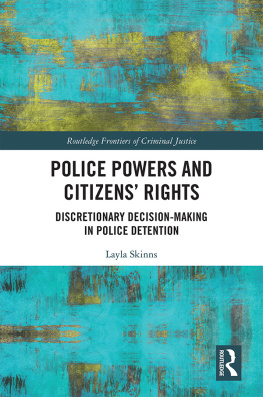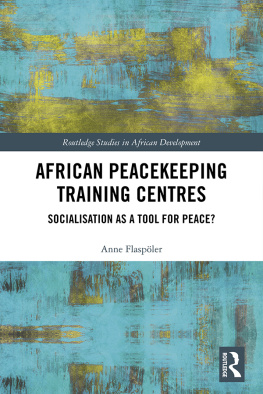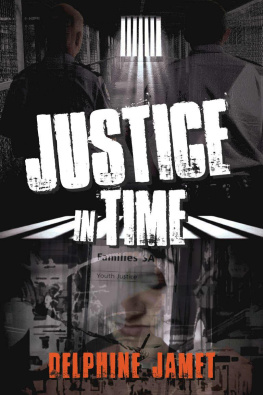The International Library of Sociology
YOUNG MEN IN DETENTION CENTRES
The International Library of Sociology
THE SOCIOLOGY OF LAW AND CRIMINOLOGY
In 15 Volumes
| I | Comparative Criminology - Part One | Mannheim |
| II | Comparative Criminology - Part Two | Mannheim |
| III | Crime: An Analytical Appraisal | Lpez-Rey |
| IV | The Criminal Area | Morris |
| V | Criminal Justice and Social Reconstruction | Mannheim |
| VI | The Education of Borstal Boys | Stratta |
| VII | The English Prison and Borstal Systems | Fox |
| VIII | The Explanation of Criminality | Trasler |
| IX | Group Problems in Crime and Punishment | Mannheim |
| X | The Institutions of Private Law | Renner |
| XI | Juvenile Delinquency in an English Middletown | Mannheim |
| XII | Legal Aid | Egerton |
| XIII | Pentonville | Morris et al |
| XIV | Social Defence | Ancel |
| XV | Young Men in Detention Centres | Dunlop et al |
YOUNG MEN IN DETENTION CENTRES
by
ANNE B. DUNLOP and SARAH McCABE
First published in 1965 by
Routledge
Routledge
2 Park Square, Milton Park, Abingdon, Oxfordshire OX14 4RN
711 Third Avenue, New York, NY 10017
First issued in paperback 2011
1965 Anne B. Dunlop and Sarah McCabe
All rights reserved. No part of this book may be reprinted or reproduced or utilized in any form or by any electronic, mechanical, or other means, now known or hereafter invented, including photocopying and recording, or in any information storage or retrieval system, without permission in writing from the publishers.
The publishers have made every effort to contact authors/copyright holders of the works reprinted in The International Library of Sociology. This has not been possible in every case, however, and we would welcome correspondence from those individuals/companies we have been unable to trace.
British Library Cataloguing in Publication Data
A CIP catalogue record for this book is available from the British Library
Young Men in Detention Centres
ISBN 978-0-415-17747-4 (hbk)
ISBN 978-0-415-51042-4 (pbk)
The Sociology of Law and Criminology: 15 Volumes
ISBN 978-0-415-17832-0
The International Library of Sociology: 274 Volumes
ISBN 978-0-415-17838-9
Publishers Note
The publisher has gone to great lengths to ensure the quality of this reprint but points out that some imperfections in the original may be apparent
CONTENTS
PREFACE
THE authors of this study are grateful to the Home Office and the Social Studies Board of the University of Oxford for the support that was given to them throughout the course of this work.
They are indebted in particular to Mr. T. S. Lodge, Statistical Adviser and Director of Research at the Home Office, for his support of the research plan and for the helpful criticism he offered as it developed.
Mr. A. W. Peterson, who was then Chairman of the Prison Commission, provided all the facilities for the research to be carried out and helped greatly with his advice and criticism while the report was being compiled.
Throughout the work, the wardens and prison officers at Werrington and Aylesbury Detention Centres showed great kindness and forbearance with the inroads that were made upon their time and with the questions that were asked of them. The officers at Werrington also took part in a long group discussion. The Wardens and deputy-wardens of the other detention centres in England and of the Scottish detention centre at Perth gave much information and advice. So too did the officers responsible for running the senior Attendance Centre at Manchester.
For advice and criticism the authors rested securely upon the support of Dr. M. Grnhut, under whose general direction the work was done.
Last of all, to the young men at Werrington and Aylesbury Detention Centres who answered as best they could the many questions that were asked of them, the authors owe the widening of their own horizons and a deeper understanding of some of the penal problems of the present time.
A NNE B. D UNLOP
S ARAH M C C ABE
INTRODUCTION
ONE of the most characteristic patterns of recent English penal policy is the rapid spread of detention centres. Any new development of this kind makes it necessary to examine the possible effects of the new measures and to test by reliable methods of criminological research whether the new forms of treatment have led to the desired results. This is particularly so with methods of treatment for which there is no previous parallel. It was from such a proposition that the present study of senior detention centres was undertaken.
From the beginning of this penal experiment, the Home Office and the Prison Commission have facilitated research into its results. A study of the first 434 boys received into the first junior centre at Campsfield House and the first 144 young men received into the senior centre at Blantyre House was published in the British Journal of Delinquency in 1960. This showed that more than one in every three of the young men committed to the senior centre did not get on well with their families, had a record of instability of employment or actual unemployment and made no attempt to use their considerable leisure effectively. The reconviction rate of this senior group within a period of two years after their release from detention was 36.1 per cent. for those released into civilian life and 43.5 per cent. for those who were returned to the army or were conscripted soon after their release.
This study of a senior centre was based entirely on records available at the centre and on evidence of reconvictions obtained from the police and the military authorities.
In view of the extension of the use of detention centres proposed in the White Paper on Penal Practice in a Changing Society it was decided to make some further attempt to evaluate the work of detention centres for the age-group seventeen to twenty-one and to see what effect this form of punishment had upon those who were subjected to it.
The great difficulty in every form of criminological research into penal treatment is to find the right criterion for success or failure. Reconviction rates will always be an important starting point but their limitations as a reliable criterion are obvious. It might be desirable for criminological purposes to supplement them by more composite studies as a test of social adjustment. Even so it would be extremely difficult to isolate the treatment factor as a possible cause of success or failure. This is particularly so when one has to deal with young people whose modes of life are bound to undergo considerable changes. It was for these reasons that the authors wished to concentrate on the personal response of the young men to the treatment awarded to them. For such attitude research a wide range of instruments appears to be available, from the casual observations by prison officers to standardized methods of interviews in depth and projective tests. From a critical point of view, all these methods have their limitations. All the evidence remains in need of interpretation and in addition the result of the attitude research is inevitably coloured by the test situation. These impediments are particularly strong in the case of attitude studies of men in prison. Any direct or indirect answer is affected, if not by wilful deceit, at least by a conscious or unconscious desire to please and to satisfy what are thought to be the needs of the interrogator.













